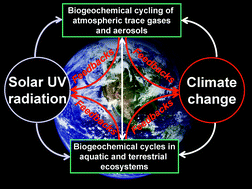Effects of stratospheric ozone depletion, solar UV radiation, and climate change on biogeochemical cycling: interactions and feedbacks
Abstract
Climate change modulates the effects of solar UV radiation on biogeochemical cycles in terrestrial and aquatic ecosystems, particularly for carbon cycling, resulting in UV-mediated positive or negative feedbacks on climate. Possible positive feedbacks discussed in this assessment include: (i) enhanced UV-induced mineralisation of above ground litter due to aridification; (ii) enhanced UV-induced mineralisation of photoreactive dissolved organic matter (DOM) in aquatic ecosystems due to changes in continental runoff and ice melting; (iii) reduced efficiency of the biological pump due to UV-induced bleaching of coloured dissolved organic matter (CDOM) in stratified aquatic ecosystems, where CDOM protects phytoplankton from the damaging solar UV-B radiation. Mineralisation of organic matter results in the production and release of CO2, whereas the biological pump is the main biological process for CO2 removal by aquatic ecosystems. This paper also assesses the interactive effects of solar UV radiation and climate change on the biogeochemical cycling of aerosols and trace gases other than CO2, as well as of chemical and biological contaminants. Interacting effects of solar UV radiation and climate change on biogeochemical cycles are particularly pronounced at terrestrial-aquatic interfaces.

- This article is part of the themed collection: Environmental effects of ozone depletion and its interactions with climate change: 2014 Assessment

 Please wait while we load your content...
Please wait while we load your content...